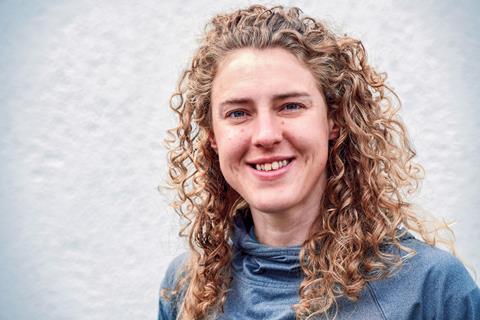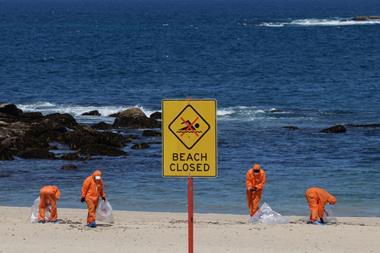In the summer of 2023, British cyclist Lizzy Banks faced every professional athlete’s worst nightmare – she was notified by UK Anti-Doping (Ukad) that she had returned an Adverse Analytical Finding (AAF) – a positive test. Ukad had identified two substances in her samples, the asthma medication formoterol and the diuretic chlortalidone.
While her asthma medication was something she had taken for years and was known to Ukad, the additional presence of the diuretic – which can be used to mask the presence of performance-enhancing drugs such as anabolic steroids – initiated a second AAF.
Banks was told that she may have committed an Anti-Doping Rule Violation (ADRV), for which she could face a two-year ban from cycling.
‘I just couldn’t believe it, there was this massive, bold, red highlighted writing and I just couldn’t comprehend what I was seeing before my eyes,’ Banks told Radio 4’s Woman’s Hour. ‘I’d been so, so careful throughout my career … I just had no idea how this could have possibly occurred.’

Guilty until innocent
David Cowan, a world expert on drug detection who led the anti-doping lab for the London 2012 Olympics, explains that with suspected doping athletes are deemed guilty until they are proved to be innocent.
‘A key point with doping is it’s on a strict liability principle,’ he says. ‘What that means is, if a prohibited substance or a metabolite of a prohibited substance is found to be present in your body, you are technically guilty.’
However, Banks was, and remains, confident that the presence of chlortalidone in a urine sample at just 70ng/ml was the result of contamination and she spent the next nine months – and her life savings – trying to prove it.
‘I was being asked to find a contaminant that was hundreds of times smaller than a single grain of salt or sugar – this minuscule amount – that was in a tablet that I’d consumed over three months ago,’ said Banks. ‘It was just an impossible task – I really felt like my whole life was over.’
Banks had previously studied medicine which, she said, gave her an understanding of the scientific background of testing. ‘I looked into the rules, I looked into all the research and started to understand that actually there were problems with contamination in the pharmaceutical industry … they don’t have to be 100% pure. But the anti-doping agencies have a zero-tolerance policy. So now with the testing sensitivity, you can test positive for a banned substance that’s a contaminant, even though it’s within the rules of pharmaceutical practice.’
Her case was eventually referred to a tribunal, but a few days before it began Ukad made a U-turn and concluded that Banks was at ‘no fault or negligence’ for the ADRV and lifted her suspension. Despite this, in an extensive account of the ordeal Banks said it had left ‘deep scars’, costing her a significant amount, both ‘literally and metaphorically’.

But her ordeal is not yet over. At the beginning of June, the World Anti-Doping Association (Wada) filed an appeal at the Court of Arbitration for Sport in respect of the decision issued by Ukad. In a post on X on 7 June, Banks said she did not know the basis for the appeal, but both she and Ukad will now be required to consider and respond to it.
WADA have appealed. I don't know the basis for their appeal, they haven't stated one. They maintain that I should have a 2 year ban & that my results should be taken away. It is both deeply disappointing yet at the same time remarkably unsurprising. 1/5https://t.co/3kaV1vD1y3 pic.twitter.com/UyOd29a3Jj
— Lizzy Banks (@ElizzyBanks) June 7, 2024
Banks’ case has opened discussions around anti-doping procedure with suggestions, by her and many others, that the process is flawed.
Over the past two decades, the analytical capabilities of anti-doping laboratories have increased dramatically, with testing now able to detect substances down to the picogram (10-12g) level. This can make it challenging to distinguish a contamination incident from intentional drug taking and experts suggest significant improvements could still be made.
The testing process
Athletes are normally tested for doping every six months. Laboratories are required to report a negative test result within 20 days. For a positive test, they can take as long as is needed to confirm a reliable result – in Banks’ case, she had to wait 79 days.
To be accredited by Wada, laboratories are required to meet a minimum required performance level (MRPL), that is the minimum they need to achieve in terms of test sensitivity. In addition to the MRPL, there are several compounds where a minimum reporting level (MRL) applies. This means that the quantity of a compound in a sample must be at that level or higher before the laboratory can report a positive test.
However, not all compounds have MRLs and while there is an MRL for six diuretics, there isn’t one for chlortalidone, the diuretic identified in Banks’ case.
Analysis in anti-doping relies almost exclusively on chromatography and mass spectrometry – both GC-MS and LC-MS. ‘They are mostly using tandem mass spectrometry, meaning triple quadrupole, or quadrupole orbitrap, or quadrupole time-of-flight detectors with low and high resolution,’ explains Mario Thevis, a forensic chemist and expert in preventive doping research at German Sport University Cologne. ‘It’s state of the art for an analytical laboratory and the test methods are designed to cover as many analytes and features in one run as possible in an initial testing procedure.’
The biggest improvements in anti-doping analysis occurred around 2010, explains Cowan. ‘Benchtop GC-MS’s became the norm and were first used at the Vancouver Olympics – that probably improved sensitivity tenfold,’ he says. ‘Then, at the London [2012] Olympics, I brought in high resolution mass spec on things like orbitraps and more full scan, untargeted types of analysis, to capture as much information as you can, then analyse it afterwards, rather than deciding beforehand.’
The testing programme for the London Olympics was considered extremely successful – between 2012 and when retesting ended in 2022, significant improvements in analytical chemistry were seen and more than 70 adverse findings were reported resulting in the redistribution of around 30 medals.
Increasing sensitivity
‘There’s a good reason why optimised analytical sensitivity is required in anti-doping tests,’ says Thevis. ‘Most importantly: testing frequencies can sometimes be very low … and that means the analytical retrospectivity that is expected from a doping control system relies almost exclusively on the detection limit.’
‘In addition to that, there are some substances that are relevant in a doping control context also when administered in very low amounts and ensuring appropriate coverage of these necessitates the capability of detecting trace levels of prohibited compounds at almost all times.’
However, this increased analytical sensitivity has introduced new challenges. ‘The flip side is that we pick up analytes that are not expected to be there and here we are confronted with the issue of differentiating,’ says Thevis. ‘Are we looking at a contamination scenario or a doping scenario?’
For some drugs, Wada has acknowledged the potential for contamination. Clenbuterol is a potent bronchodilator, but it is known to be abused by athletes and bodybuilders as it promotes lean muscle development. However, the substance is also used as a growth promotor in livestock in Mexico, China and Guatemala. ‘Clenbuterol is in foods illegally in many countries in the world – you could end up eating some contaminated food without realising,’ says Cowan.
This was one substance for which Wada introduced an MRL. In 2019, it stated that low levels of clenbuterol (urine concentrations <5ng/ml) present in an athlete’s sample could be reported by a Wada-accredited laboratory as an atypical finding and investigated as a contamination case.
Another example is the beta-2 agonist higenamine, which can be found in fruit. ‘If you eat a lot of a certain species of South American fruits, you are very likely to have that in your system and, consequently, in your urine sample,’ says Thevis. ‘But then there is a minimum reporting level, which is set at a level that you would, under most likely circumstances, not exceed [even] if you have a diet exclusively based on such South American fruits.’
But there are also contamination risks that are less well-understood and for which MRLs do not currently exist. For example, Cowan explains that there is a danger of contamination in many supplements.
‘If you’re using supplements, a key question [is], do you need to be using supplements?’ he advises. ‘Supplement manufacturers like to sell their product, like to market them, like to push them, and there’s a risk then of a contaminant.’
And there are also risks in regulated medicines. Pharmaceuticals have been found to be a source of contamination with diuretics such as hydrochlorothiazide, which is prohibited by Wada at all times.
‘What is really unfortunate is pharmaceuticals may be contaminated as well,’ Cowan adds, ‘but with minute amounts, not enough to have a pharmacological effect, not enough to require the regulatory body to say you’ve got to control that contaminant, but enough to affect sport, at which point I tend to say, why isn’t there MRL for those compounds ?’
Possible improvements
Currently, MRLs have only been defined for around half of substances. ‘For some things Wada are good,’ says Cowan. ‘But, unfortunately, the Wada rules don’t cover all possibilities and permutations.’
Wada has several working groups, including one focused on contamination, which regularly reviews drugs and MRLs, but Banks’ investigation suggested that Wada does not hold a comprehensive list of all possible contaminants.
And while some suggest more MRLs are needed, it isn’t always that straightforward. For example, Thevis explains, if there had been an MRL for anabolic steroids when re-analyses of the doping control samples collected at the London Olympics were conducted, the programme would probably not have produced the same number of adverse findings.
‘Anabolic steroids are potent drugs – used to stimulate muscle growth, for increased recovery, for increasing the overall athletic performance,’ he says. ‘That increased performance can last for weeks, if not months.’ The same challenges are true of other substances that can improve performance for a long time, such as growth hormone or erythropoietin.
‘It’s not black and white, it is a bit more complicated,’ says Thevis. ‘I fully understand the frustration of an athlete who is challenged with an adverse finding and is certain that it can only be the result of a contamination scenario – this is usually very difficult to prove.’
‘I’m sure there are ways to improve the system and we are trying our best to contribute to that,’ he adds. ‘But merely deciding that, below a certain level adverse findings should not be reported is probably not the solution.’
So what is the answer and how can cases like Banks’ be avoided in future? Much more frequent testing could help, says Thevis. ‘Being tested frequently is actually protecting the clean athlete,’ he explains. ‘If someone tests positive at a low concentration in one sample, the result management authority can revert to analytical data from earlier collected samples, eg from three or seven [tests] ago. If these are negative under comparable analytical conditions, then the adverse finding can’t possibly represent a doping scenario.’
Cowan says education plays a big part too. ‘Generally, you can’t stop [doping], but you can try to mitigate it. Education is part of it, making it clear what the rules are, making sure that everyone involved in sport is familiar with that.’

















No comments yet